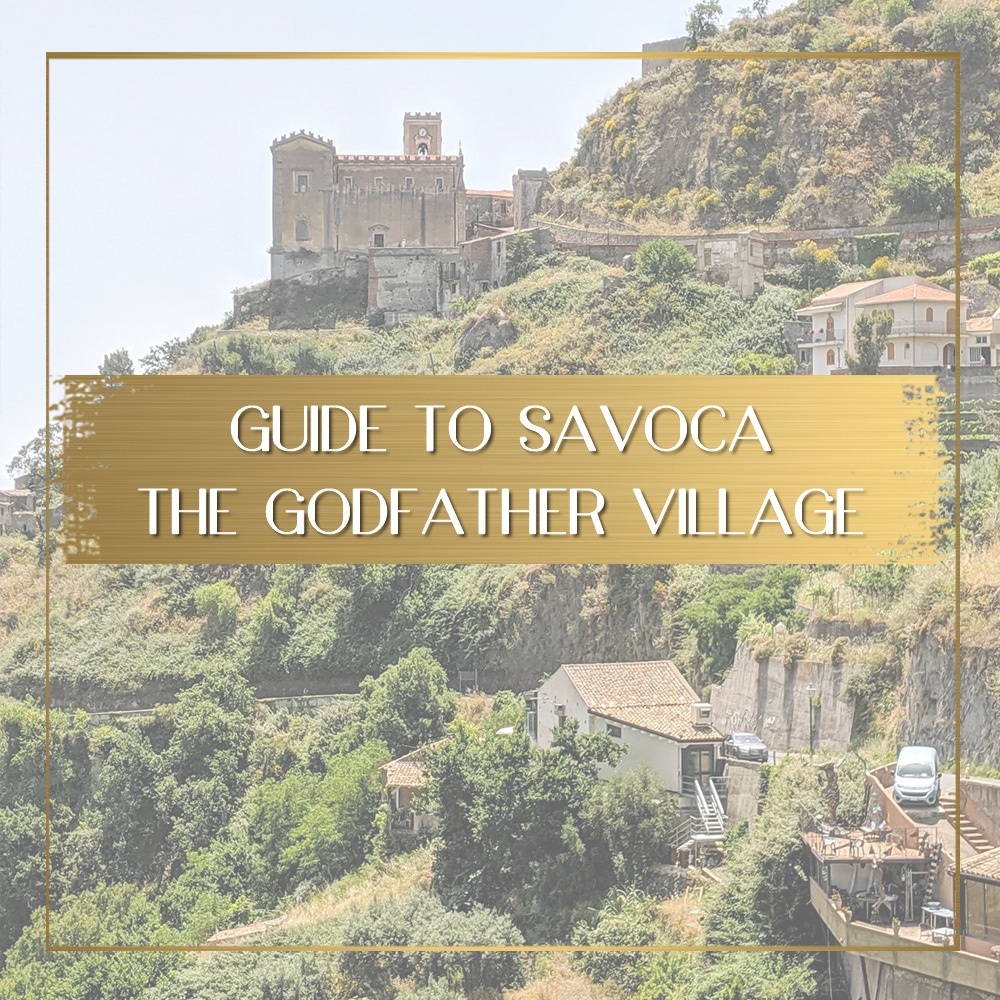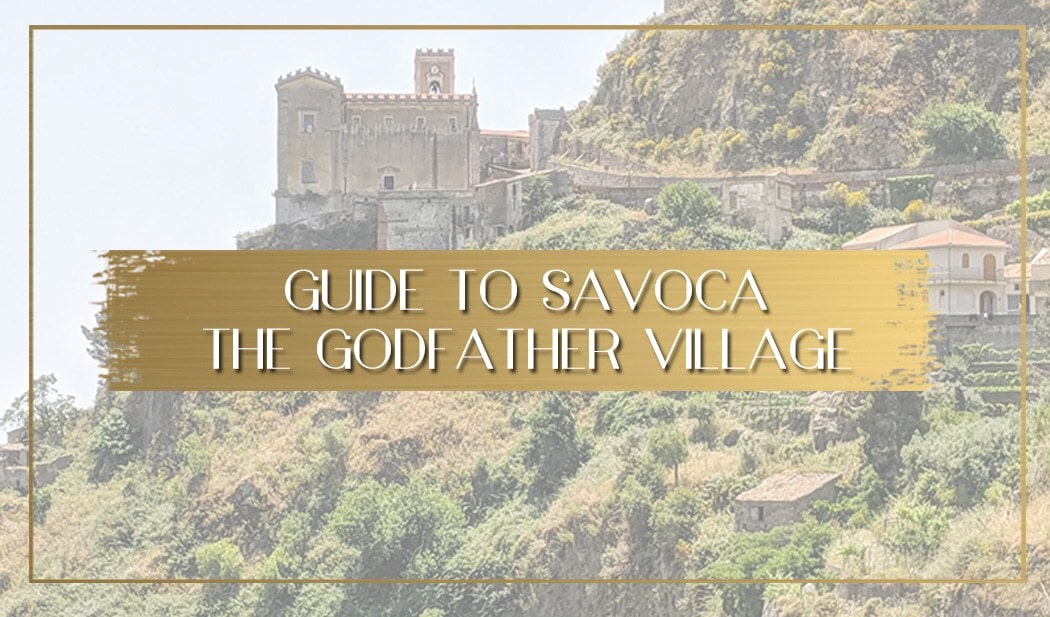Savoca is a small Medieval town on the hills above Taormina, in Sicily, made famous by The Godfather. Some of the movie’s most recognizable Sicilian backdrops can be found in town and practically unchanged.
Tourists flock to the village during the day but come night, Savoca is as quiet as rural life in Sicily can be. This is not to say that there is nothing to see in Savoca, much the opposite. For a town of this size, there are quite a few places to visit, especially on a road trip across the continent.
There is only one hotel in town, a few souvenir shops and a couple of restaurants, in addition to the famous Bar Vitelli, if what you are looking for is peace after a few busy days in Taormina, you will find it in Savoca.
A bit more about Savoca
Savoca is a tiny pedestrian-only medieval town where the important Sicilan scenes from The Godfather were shot. Several landmarks in the village are featured in the movie and even the locals starred as extras.
The town has less than 2,000 inhabitants and is perched by the side of a cliff with stunning panoramic views over the coast below and a privileged position that made it a strategic place for the Norman.
From Savoca you can see Mount Etna at one end, the Ionian Sea on the other and, on a clear day, the coast of Calabria in Italy’s mainland across the water.
It is clear to the inhabitants of Savocca that The Godfather has brought them pride and plenty of business opportunities. But besides the tours and souvenirs for sale, there is little more happening in town.
You can find a kiosk a few meters from Bar Vitelli towards the church that sells Ape tours of the hilly town, and most of the places that are open for business sell memorabilia or items tourists may need, like snacks and water.
But there is more to Savoca than The Godfather and before it was made famous by the movie it was already a pretty medieval village and an important town during Norman times.
Things to see and do in Savoca
As I mentioned, Savoca is a tiny town that’s right above the hills of one of the busiest parts of Sicily, yet it makes you feel like you are miles away from civilisation. The streets are quiet, there are wild prickly pears and apricot trees by the side of the road and the air, in summertime, is filled with the warm scent of the land.
Here are some of the things you can see and do in Savoca.
Snap a shot with Coppola
The locals have paid homage to Coppola with a shiny mirror-like metal sculpture of him in front of Bar Vitelli, and another of a man and a donkey on the road that leads into town.
Recreate the scenes at Bar Vitelli
Perhaps the most recognizable of all The Godfather filming locations is Bar Vitelli. Looking essentially as it did when the movie was shot, this 18th century palazzo is a pleasant place for a drink, gelato, cake or a Sicilian granita.
The outdoor shaded patio has some tables and chairs and is where the movie scenes from The Godfather 1 were shot.
Inside you will find a room to the right where a variety of Savoca, Sicilian and The Godfather memorabilia is hung from the walls. You can see photographs of the movie scenes shot in the village and the Sicilian symbol, the Gorgon with three legs, because the island is three-pointed.
In mythology, Gorgon is the sister of Medusa and is said to turn you into stone if you look at her in the eyes. This symbol was traditionally placed outside Sicilian houses so people would not look in. It is also in the Sicilian flag.
In the room to the left is the bar, with a large display fridge showcasing the cakes and sweets and a variety of souvenirs for sale. I could not resist buying a small bottle of Godfather-themed limoncello.
Bar Vitelli is the place where Al Pacino meets his wife Apollonia and where he later comes back to ask for her hand in marriage from her father, owner of the bar. The pair sit at a small table by the main door that is still there.
When he is talking to his friend about Apollonia, her father hears them and makes out that they are referring to his daughter and becomes pretty upset. He tells Al Pacino, “In this town the women are beautiful and virtuous”.
Take a seat and enjoy a drink under the same vines, and listen to the traditional Sicilian music or the movie famous soundtrack playing in the background, as if time stood still. See reviews and pictures of Bar Vitelli here.
Church of Sant Nicolo
This 15th century Norman church is where Apollonia and Michael got married and also looks exactly like in the movie. The original construction is Norman but was damaged during the 1693 earthquake that destroyed much of Catania and had to be restored after.
The church is stunning in its own right, literally built on the side of the mountain, its foundation relying on ancient rocks, it has one of the most impressive locations of all the churches in Sicily.
The absys shows the life of Santa Lucia, a venerated saint in Sicily, patron Saint of Syracuse. In the church her entire story is explained through paintings. Lucia was praying for her mother’s illness when Santa Agata told her that her mum would be fine but she would spend her life following Jesus.
Inside the church you can see a picture of the weddings scene from the movie and all the items used for the annual procession of Santa Lucia are on display with photographs to illustrate how they are used and explanations.
The Crypt of the Capuchin Convent
Another interesting place to visit in Savoca, if not a Godfather filming location, if the crypt of the Capuchin Convent where you can see 19th century mummies from up close.
These mummies belong to noble men and monks from the time which were preserved using natural desiccation methods and are on display in the crypt. The bodies are either standing in niches on the wall or laying inside glass coffins. You can read the names of some of them on papers attached to the coffin.
This kind of mummification was common in Sicily until Napoleonic times and the largest catacomb can be found in Palermo where more than 1,500 bodies were found.
The Capuchin monks arrived in Savoca to teach people religion and still live in the convent attached to the crypt. Photos are not allowed inside the crypt. Entrance is free but you are encouraged to leave a voluntary donation.
Chiesa Madre
This is the main church in Savoca built in the 13th century and renovated after the earthquake of 1693. You can see the remains of the former church at the back, in some niches on the wall which contain the statues that were preserved.
This is also where the mummies were prepared, in the basement of the church, on a seat-like space on the wall where the corpses were left to dry.

